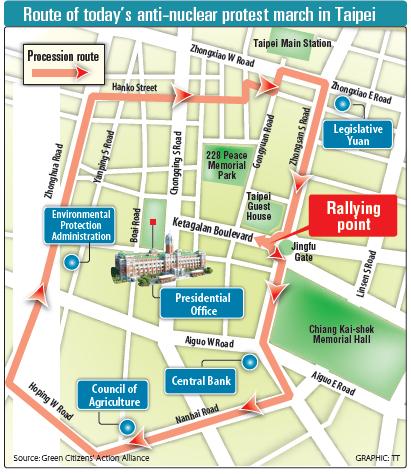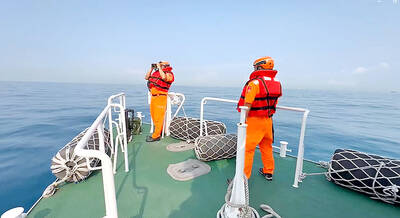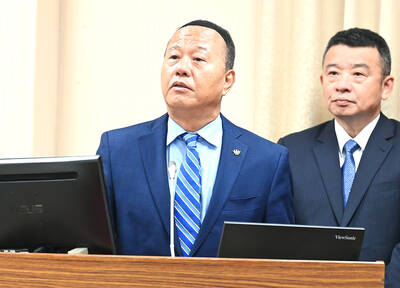The Taiwan Environmental Protection Union yesterday criticized the Chinese Nationalist Party’s (KMT) question for a proposed referendum on halting the construction of the Fourth Nuclear Power Plant, saying the text showed that the party was exploiting the shortcomings of the Referendum Act (公民投票法) to ensure construction continues.
The wording of the proposal, which was unveiled on Thursday, says: “Do you agree that the construction of the Fourth Nuclear Power Plant should be halted and that it not become operational?” (你是否同意核四廠停止興建不得運轉).
National Taiwan University professor Shih Hsin-min (施信民) said yesterday that the ruling party is trying to use the requirement that states that at least 50 percent of voters must submit ballots for a referendum to be valid to veto the proposal to halt construction of the nuclear power plant.

“They [the KMT] were really wearing their hearts on their sleeves — which say: ‘Let the construction continue,’” said Shih, who is also the president of the Taiwan Environmental Protection Union.
He said the government has always supported the construction of the power plant ever since it decided to resume the project on Feb. 14, 2001, adding that position has recently been reiterated by both President Ma Ying-jeou (馬英九) and Premier Jiang Yi-huah (江宜樺).
“They should ask if the public agree that construction of the Fourth Nuclear Power Plant be continued and that it become operational,” Shih said. “That would be a real referendum on government policy.”
Lai Chen-chang (賴振昌), president of the National Taipei College of Business, said the nation would pay a heavy price if a nuclear disaster strikes, no matter how low the chances of it happening. He said not only this generation, but the next, would continue to pay the price, adding citing the example of the Chernobyl nuclear disaster.
“An incorrect government policy is worse than a corrupt government,” Lai said. “The Ma administration has tried to explain its policy by pointing out the costs, but it has ignored the costs that the nation would have to pay for a nuclear disaster.”
National Taipei University economics professor Wang To-far (王塗發) said that the KMT’s proposal completely downplays the negatives of nuclear energy.
“What we are facing is an evil, cold-blooded and shameless government,” Wang said. “They said what happened at [the] Fukushima [Dai-ichi nuclear power plant in Japan in 2011] was mainly the result of human error, as if we are running safe nuclear power plants. Haven’t we learned the lesson of Fukushima?”
National Chiao Tung University civil engineering professor Liou Gin-show (劉俊秀) said that those living within a 30km radius of the Fukushima Dai-ichi nuclear power plant had to evacuate after the nuclear accident there. Were the same rule to apply here, 7 million people would have to be evacuated in the event of a disaster, he said.
“The rule here is 8km. Can they even do that?” Liou asked.
With anti-nuclear protest marches due to take place nationwide today, the union said more academics should come out and support the cause.
According to the Green Citizens’ Action Alliance, the civic group that initiated today’s protests, more than 22,000 people have sent text messages endorsing the movement to abolish nuclear power and it estimated that the march in Taipei would draw more than 30,000 people.
Additional reporting by CNA

An increase in Taiwanese boats using China-made automatic identification systems (AIS) could confuse coast guards patrolling waters off Taiwan’s southwest coast and become a loophole in the national security system, sources familiar with the matter said yesterday. Taiwan ADIZ, a Facebook page created by enthusiasts who monitor Chinese military activities in airspace and waters off Taiwan’s southwest coast, on Saturday identified what seemed to be a Chinese cargo container ship near Penghu County. The Coast Guard Administration went to the location after receiving the tip and found that it was a Taiwanese yacht, which had a Chinese AIS installed. Similar instances had also

GOOD DIPLOMACY: The KMT has maintained close contact with representative offices in Taiwan and had extended an invitation to Russia as well, the KMT said The Chinese Nationalist Party (KMT) would “appropriately handle” the fallout from an invitation it had extended to Russia’s representative to Taipei to attend its international banquet last month, KMT Chairman Eric Chu (朱立倫) said yesterday. US and EU representatives in Taiwan boycotted the event, and only later agreed to attend after the KMT rescinded its invitation to the Russian representative. The KMT has maintained long-term close contact with all representative offices and embassies in Taiwan, and had extended the invitation as a practice of good diplomacy, Chu said. “Some EU countries have expressed their opinions of Russia, and the KMT respects that,” he

AMENDMENT: Contact with certain individuals in China, Hong Kong and Macau must be reported, and failure to comply could result in a prison sentence, the proposal stated The Chinese Nationalist Party (KMT) and the Taiwan People’s Party (TPP) yesterday voted against a proposed bill by Democratic Progressive Party (DPP) lawmakers that would require elected officials to seek approval before visiting China. DPP Legislator Puma Shen’s (沈伯洋) proposed amendments to the Act Governing Relations Between the People of the Taiwan Area and the Mainland Area (臺灣地區與大陸地區人民關係條例), stipulate that contact with certain individuals in China, Hong Kong and Macau should be reported, while failure to comply would be punishable by prison sentences of up to three years, alongside a fine of NT$10 million (US$309,041). Fifty-six voted with the TPP in opposition

VIGILANCE: The military is paying close attention to actions that might damage peace and stability in the region, the deputy minister of national defense said The People’s Republic of China (PRC) might consider initiating a hack on Taiwanese networks on May 20, the day of the inauguration ceremony of president-elect William Lai (賴清德), sources familiar with cross-strait issues said. While US Secretary of State Anthony Blinken’s statement of the US expectation “that all sides will conduct themselves with restraint and prudence in the period ahead” would prevent military actions by China, Beijing could still try to sabotage Taiwan’s inauguration ceremony, the source said. China might gain access to the video screens outside of the Presidential Office Building and display embarrassing messages from Beijing, such as congratulating Lai